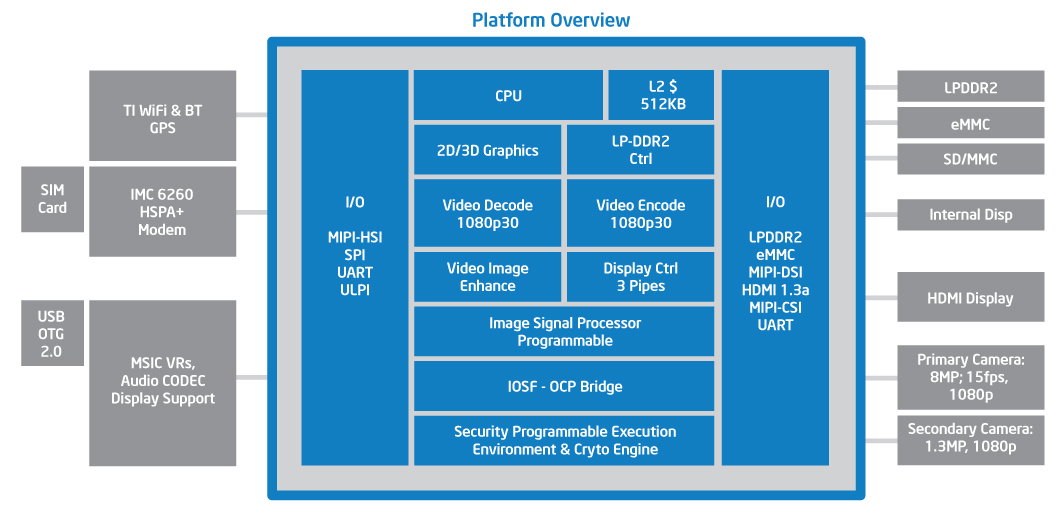We started to doubt Intel in smartphones since Qualcomm Krait is just weeks from retail products. The company has now geared up and has announced a new system processor with two Atom cores, Hyper-threading and a graphics processor faster than Apple A5.
Even if Intel has shown great interest in the smartphone market it hasn’t really revealed that much about its coming system processors. We knew there was a system processor coming for the lower price segment, but its Atom Z2460 was far from the best it could do. Its system processors have better yields than expected, therfore Z2460 comes with a Turbo at 2.0 GHz – instead of 1.6 GHz. The base frequency will be the same at 1.3 GHz.
| Model | Intel Atom Z2000 | Intel Atom Z2460 | Intel Atom Z2580 |
| Node | Intel 32nm LP | Intel 32nm LP | Intel 32nm LP |
| Cores/threads | 1/1 | 1/2 | 2/4 |
| Clock frequency |
1.0 GHz | 1.3 GHz | 1.3 GHz |
| Turbo | – | 2.0 GHz (prev. 1.6 GHz) | 1.8 GHz |
| Graphics | PowerVR SGX 540 | PowerVR SGX 540 | PowerVR SGX 544MP2 |
| Graphics frequency |
320 MHz | 400 MHz | 533 MHz |
Another chip has surfaced in a higher performance segment: Intel Atom Z2580. Z2580 gets a total of two Atom cores at 1.3 GHz with Hyper-Threading, and have a Turbo mode up to 1.8 GHz. The graphics processor consists of a PowerVR SGX 544MP2, which is basically the exact same as SGX 543MP2 found in Apple’s A5 processor found in iPhone 4S and iPad 2. The difference is that SGX544MP2 gets support for Direct3D 9_3. The clock frequency is up high at 533 MHz, which is nearly double of what Apple A5 has to offer, in theory.
Last we have Atom Z2000, which is basically the same chip as Z2460. The difference is the lower clock frequency at only 1,0 GHz, no Turbo mode or HyperThreading and the graphics is set to only 320 MHz. It still supports decoding 1080p video, but the transcoding is limited to 720p. Z2000 will target the lower price segments, where mainly ARM11-based system processorer are selling. Up ahead ARM Cortex-A9 and Qualcomm Scorpion-based processors will also be used in budget smartphones. one Atom core at 1.0 GHz should be fast enough then, and the only thing that can go wrong really with Z2000 is the price.
 Platform overview of Atom Z2000 and Atom Z2460
Platform overview of Atom Z2000 and Atom Z2460
Z2000 and Z2460 comes with similar baseband (XMM6265 and XMM 6260) with support for 3G and HSPA+ 21 Mbps, in Intel’s reference platform. Offering a reference platform reduces development costs for smartphones, but if manufacturers wants it can add or remove chips. Z2580 comes with the XMM7160 LTE circuit, and supprots HSPA+ 42 Mbps.
Too little, too late again?
Intel’s roadmaps does look positive, but Z2000 and Z2580 will be in retail for a very long time. Intel will ship the Z2580/XMM7160 reference platforms in the latter half of the year, so retail products will take another six months. The Z2000/XMM6265 combination, that is basically Z2460/XMM6260, should appear a bit sooner than that.
We at least hope that the new system processors will not be too little, too late, which Z2460 gave us the impression of being. Especially considering the benchmarks we have seen with Qualcomm’s new Krait architecture and later this year Cortex-A15-based system processors. In the end the most important challenge is to offer good performance at low energy consumption. Intel have earlier made statements about how it will use its world-leading manufacturing technology to its advantage, and we think it will need it to compete with the giants on the mobile market.
Source: Anandtech





















I think this is, in fact, perfect timing. Seems this will enable x86 based tablets which will be able to run full blown windows 8 without being restricted to just metro apps like the arm based windows 8 based tablets.
Microsoft surely needs this if it expects to succeed in the tablet market.
@Davoid
This article is about Medfield, for phones. What you’re referring to, x86 Wintel in tablets, is a separate project from intel called Clover Trail 🙂